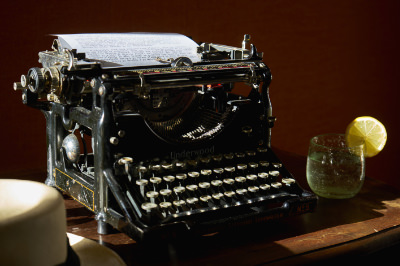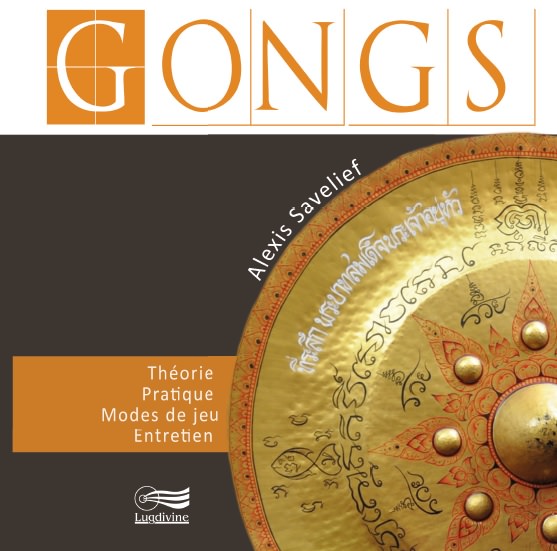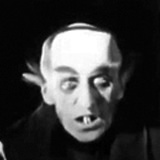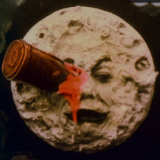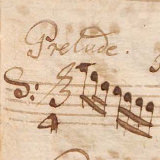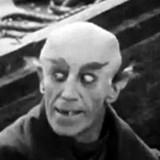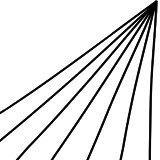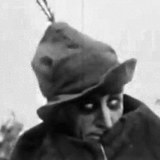Interview with Broder Oetken
Gongmaker & Gongmaster
Interview with Broder Oetken,
Gongmaker & Gongmaster
Interviewed by Alexis Savelief between May and July, 2015
You can also read the French version of this interview.
Musical instruments are often very intriguing and whimsical; they entertain a curious relationship with their visual aspect, that is both related and irrelated to how they actually sound. In that respect, despite their seemingly simple appearance, gongs require a particularly high degree of craftsmanship to make. And with my background as a musician, I am always curious about musical instruments, especially when it seems as complex and mysterious as making a gong.
As a matter of fact, gongs are much in demand since a few years. Yet, apart from rare places like the GongForum (not online anymore) or the Website of Philip McNamara (not online anymore), it is difficult to find much information about gong-making, gongs themselves, their tuning and their design; nothing more than the same generic descriptions of their subjective characteristics (yes, it is kind of a paradox!).
But today, we have the chance to interview Broder Oetken, gongmaker at Oetken Gongs, his gong-making company. This will be our chance to know more about gongs, about his work, and about what we can expect in this field in the upcoming years.
Before reading this interview, I advise you to have a look at his gongs on the Website of Oetken Gongs and on his Facebook page to have an idea of the kind of gongs he make.
BACKGROUND:
A.S.: Hello, Broder Oetken. Thank you for taking the time for this interview. Let’s begin with a little background information about you, and a general overview of your activity.
I have read on your Website that you do not come from a musical background. How did you get involved in gongs in the first place?
B.O.: I trained to work as a civil engineer, and became a gongmaster only by chance; and because I liked it, I have been making gongs until now.
You have worked at Paiste for a number of years, first as an apprentice with Walter Meyer, and then as a gongmaster. (Note: Walter Meyer is at the onset of many experimentations, and responsible for the elaboration of some of the “Sound Creation” gongs from Paiste.) I am under the impression that Walter Meyer has been very important to you; I have seen on your Website that you have made a series of one-of-a-kind gongs: the “To remind Walter” line.
My main knowledge in gongmaking, I’ve learned from Walter. I say “main knowledge” wilfully, because Walter got ill during my apprenticeship. At this time, Rudi (Note from Alexis: Rudi Bonness), who was the first gongmaster of Paiste, came to stay on my side, and he taught me a lot. By the way, Walter himself was formerly a Rudi’s apprentice, and then became the second gongmaster. So I had two teachers: the first and the second gongmasters. Because they had different styles of gongmaking, I had the chance to learn both ways.
There are two reasons for me to create the “To-remind-Walter gongs:”
- Walter was very important to me.
- I bought the material from Walter’s widow when she dispersed his little factory garage after he left. This is the material I use for these gongs, on the one hand to remember Walter, and on the other to make it clear that this is not the same material that I use for the other gongs ― because I’m not really sure about the material.
After your apprenticeship with Walter, Rudi and your years as a gongmaster at Paiste, when did you leave the company to set up your own gong-making company: Oetken Gongs?
The cooperation with Paiste ended in 2010.
MORE ABOUT OETKEN GONGS:
So, Oetken Gongs, founded subsequently in 2011, is a very young company. Yet, there are a lot of things going on… What is the core of your activity: Do you mostly make gongs for other companies?
My main production is the Meinl gongs, but next to them I’m developing my own Oetken gongs, and, not the least, the Ollihess gongs.
That seems a very good start for a young company in a niche market as gongs are. Gong-making is a not-so-common craft. What do you like so much about gongs and gong-making?
That’s one of the main things:
It’s not very common — not everybody is able to do it. On the one side it is a very creative job, and on the other side, high accurateness is required.
MAKING A GONG:
Now, it is time to take a closer look at the “birth” of a new gong.
First, I suppose that gong-making is a very time-consuming and labor-intensive task. I have read somewhere that a 40” gong takes twice as much time as a 36” gong to make. To give us a better idea, could you tell us how much time is required to build various gong sizes?
Yes, you are right — it’s very time- and labor-intensive to build a gong. And yes, almost twice more time is needed to make a 40” rather than a 36”. Altogether, it’s hard to tell the time for each size.
What is the process of making a gong, from the metal blank to the finished gong on the stand?
To itemize the individual steps:
- Plotting
- Glowing
- Hammering the edge
- Tuning
- Scratching
- Cleaning
- Waxing
- Fine-tuning
Eight steps: That is a lot! Your summary is interesting, because I am not sure that many people realize all the work behind it when they see the resulting gong.
DESIGNING A NEW PROTOTYPE:
And now, what is the process of designing a new prototype of gong: Do you hear a sound in your head that you want to materialize with a gong? Or is it a visual design that you want to try and see if the sound is interesting? Or else, do you just take a new metal blank, a hammer, and try to get something out of it with no preconceived idea?
As a matter of principle, all three ways are possible — but there is also a fourth way:
There are different areas on a gong which are responsible for particular sound effects: I can imagine that some kind of development can achieve interesting effects. These are plans I have for the future. As of now, I’ve tried all ways except the third — just to hammer on a blank to see what happens is too expensive in my mind.
I see that your gongs are made in alpaka. Is it different from the NS12 metal used by other gong manufacturers? Does it have special sound characteristics?
Alpaka is NS12. In my sense, alpaka is the best material for gongs.
When someone submits an idea to you for a new prototype of gong, do you know in advance the approximate resulting sound, just from the design, or is gong-design more unpredictable?
I have a perception of some properties — but they may not be true in every case. Most of the time, with my imagination I was right, but I have also been disappointed in one try.
Does it take many prototypes to come up to a result you judge satisfying for a new gong design?
It’s different from case to case. In one case it is only one, and in another case I need more than one. For example, I have made a number of prototypes for Meinl, for them to be able to decide which range they wanted to offer. (Note from Alexis: Some prototypes of the Meinl series are offered for sale through some retailers.)
SOME INTERESTING DESIGNS IN THE OETKEN GONGS CATALOGUE:
When I have a look at your current catalogue, I can see that you came up with some very unique gong designs, and a lot of one-of-a-kind gongs with exciting visuals (the “To-remind-Walter” series). Unfortunately, there is no sound sample. Could you tell us a little more about them?
We tried to write some words about the sounds of the gongs on our Website. But it’s always hard to describe something as subjective as a sound sensation with words. We are living to see several reactions with different players while they are playing our gongs.
It’s similar with the sound files of gongs: You need the best equipment and you won’t get the real sound of the gong. You can’t catch the sound experience. That is the reason for us not to offer sound files.
If someone is interested in our gongs, we always find a way. :)
Yes, I understand exactly what you mean when you say that sound files can not faithfully capture the sound and essence of a given gong; gongs can produce such a wide array of sounds and atmospheres!
Now, looking at some specific gongs: For example, the “Heart gong”. How did you get the idea for this gong? Compared to a Symphonic gong, what kind of sound does it produce? And is it tuned to a particular note/frequency?
The idea for the heart gong comes from a customer (Note from Alexis: This customer is Graham Bater, in the UK.). In comparison with a symphonic gong, the sound of the heart gong is deeper and opens faster and more.
It isn’t tuned to a particular note. It’s possible to have two heart gongs with the same frequency, but we don’t check the note, because the sound characteristic is the main important feature. Like the symphonic gong — it isn’t tuned either.
Then, there is the “Water gong”. It is a very large gong (40”), and from the photograph on your Website, I can see that there is a deep inverted boss in the center. If it is based on the smaller (24”) version made a long time ago by Walter Meyer, for what reasons did you decide to make your take on this gong larger?
Here we have the step we spoke about before: I wanted to attempt and see what would happen with the sound if I made a large gong, inspired by the Paiste Sound Creation #4 Water gong.
There is also the “Thor’s hammer” gong (40”). How did you get the idea for this singular gong? I suppose that the raised area shaped as a hammer has an impact on the sound, too. How could you describe the sound, compared to a Symphonic gong of the same size?
The idea for the Mjölnir gong was nearby:
We are living around one of the biggest trading centers of the Vikings (Note from Alexis: Oetken Gongs is based near Rendsburg in Northern Germany). Mjölnir was the hammer of Thor, and it’s a very strong symbol we can see very often here around. Thor protected the humans with Mjölnir’s help, and there is thunder when Thor uses it for hammering. The mythology tells that Mjölnir never miss it’s target ― therefore, the circle is closed back to the gong-making process!
In comparison with a symphonic gong, the sound of Mjölnir is deeper… you can imagine the roll of thunder.
ABOUT THE TUNING OF GONGS:
Let’s now delve more in-depth in the subject, and speak a little about the tuning of gongs. Except for diameter and thickness, this area is rather mysterious for me, as there is very little relevant information available, and I am always amazed at the variety of sounds that can come from gongs that seem very close visually except for minute details.
I have always been curious about the vertical, horizontal or radial scraping marks on the sheet gongs. Are they meant solely for aesthetics, or do they serve a purpose?
The scrapes are bursting the surface tension and produce more flexibility in the gong.
Is the rim area burnt mainly for aesthetics and to ease working the metal, or has it a particular property regarding the sound?
We glow the material to make it a bit softer.
On the one hand it gets the hammering a little bit easier, and on the other hand, the risk of rupture is reduced.
Does the deepness of the folded edge have an impact on the sound?
Yes, but it is very difficult to describe which effect it has.
Now, when you tune a gong, do you tune only the fundamental, or also the overtones, or only part of the overtones?
I don’t know.
There are more than these three components which have to be respected for the tuning. It is too complex to answer in just a few sentences.
What are the critical parts of the design of a gong that have an influence on the tuning of the fundamental tone? And on the predominant overtones?
Sadly, I can’t reply to this question easily, too. This is too complex to explain it in the context of this interview.
What can you say about the tuning process: Do you use a purely physics/mathematics formula? Or is it a process of working on the tuning by hammering, then testing it against a tuner, refining the tuning, testing again, and so forth?
Sure, one part is hammering and testing, but it isn’t just hammering and holding the fingers crossed hoping to strike the right tone!
Right, that is the interesting part in gong-making: to have the experience of where and how strong to hammer to get the wanted result, to think about and then to check.
Are two gongs of the same reference in the same size in the same series sounding exactly the same, or are there some subtle or not-so-subtle differences?
In the best of cases, two gongs could be like twins. But because of the hand-craft by a human being, there are almost always fine differences between them. But there are other important factors to consider, for example:
- The age of the gong
- How often the gong was played
A FEW WORDS ABOUT THE FUTURE:
We arrive almost at the end of this interview; we shall speak a little about the future.
In recent years, there have been a lot of exciting new developments in the area of gongs, and I can see that a lot of things are going on on your side, too!
What do you think of sound healing and gong baths, which seem to be behind this renewal of interest for gongs?
I’m not well-schooled in this, but I think that it’s fantastic what people can produce with gongs and use them for. We know people who are able to make persons “just” feel good, and on the other side, there are people who are able to help other with their pain. That’s fantastic!
Are you currently working on new ranges, or new prototypes of gongs, with new properties, or new sounds?
Yes, but it’s too early to speak about it.
When there is something new, we’ll show it on Facebook or on our Website.
What are your projects for Oetken Gongs, in the near and not-so-near future?
In July, we’ll have our next workshop “Metal Turns Sound,” with a lot of interesting people. In this workshop, people are welcome to try and feel gong-making (with a little help). We are looking forward to this week-end.
In the long-term future, my intention is to bring the development of gong-making further, to learn a lot about it, and to pass my knowledge to my employees, in order that this rare handcraft continues.
It’s amazing how many persons are interested in gongs and gong-making. We get to know a lot of great and nice people, and it’s fantastic to learn about several playing techniques, but also miscellaneous minds and feelings.
The “Metal Turns Sound” workshop seems very interesting; this is a fabulous idea… I should participate to this workshop one day if I can, to get a first-hand feel for gongmaking! Moreover, I am glad to see that you have a lot of projects going on, and that you are moving in a direction of pushing boundaries with gong-making!
Is there something else that you would like to say about gongs, about the current state of gong-making, or your activity?
Thanks for you interest in my work. I hope that I was able to contribute to your understanding with my answers.
We wish you all the best for the future, and we are looking forward seeing you in our factory in Germany. Maybe you are around someday!
Yes, I hope that I will be able to come one day!
Thank you very much for having taken the time to answer my questions, and for sharing your passion with us, Broder. I wish you the best of luck for your present and future projects!
Special thanks to Ines Oetken.
CONCLUSION:
After this lengthy interview, I am under the pleasant impression that Broder Oetken is a gong-maker to keep an eye on! He makes beautiful gongs, and compared to other gong manufacturers, he is indubitably the more active in innovation and experimentation.
Since the time of this interview, Oetken Gongs has introduced two new gongs with non-scraped surfaces: the “Mermaid” gongs (“Himeropa” and “Himeropa Ligeia”), perfect to play with superball mallets. Moreover, most of the special gongs, formerly available only in very big diameter, are now available in more sizes.
I recommend that you check his Website http://www.oetken-gongs.de, as well as the Meinl and Ollihess Websites, for whom he develops and makes gongs. Moreover, on these last two Websites, you will find videos that will give you an idea of some of the sounds you can achieve on his gongs. At last, do not hesitate to follow him on Facebook to keep up-to-date with his work and new developments; he and his wife (who administers the Facebook page) are very nice people.
WHERE TO FIND BRODER OETKEN GONGS:
The gongs Broder make for Meinl are quite widespread and can be purchased in a variety of places, because they are widely available. The Ollihess gongs can be bought online on his Website. And if you are interested in a gong from the Oetken Gongs catalogue, you can purchase it either by contacting him directly on his Website, or in the UK through Julian Marsden at http://www.ecymbals.co.uk. Hencefort, Broder Oetken gongs are also available via Gongs Unlimited in the United States of America, on Meditation Gongs in Germany and on Shanti Sounds in Costa Rica.
… Savez-vous que vous pouvez vous ABONNER à notre lettre d’information ?
Sélectionnez les catégories qui vous intéressent, puis entrez ci-contre votre prénom et votre adresse de courriel !
